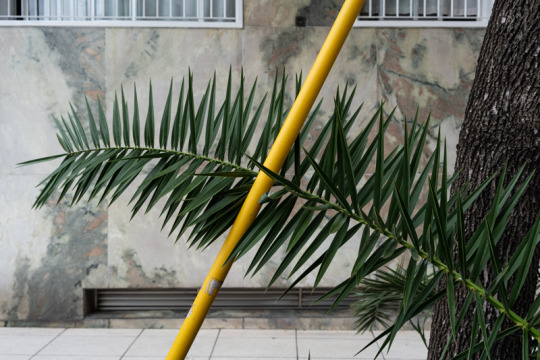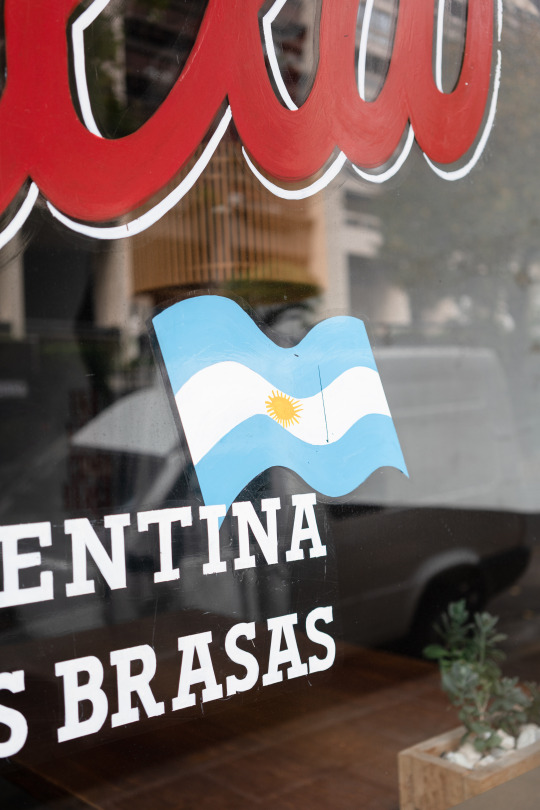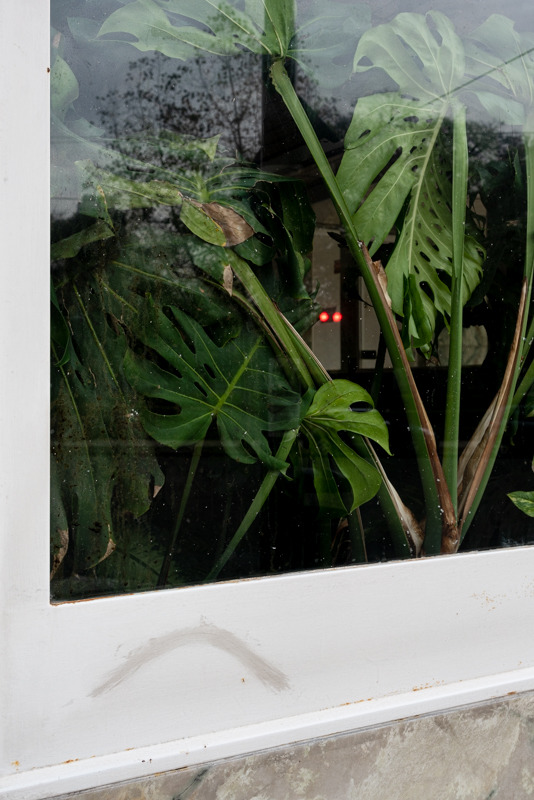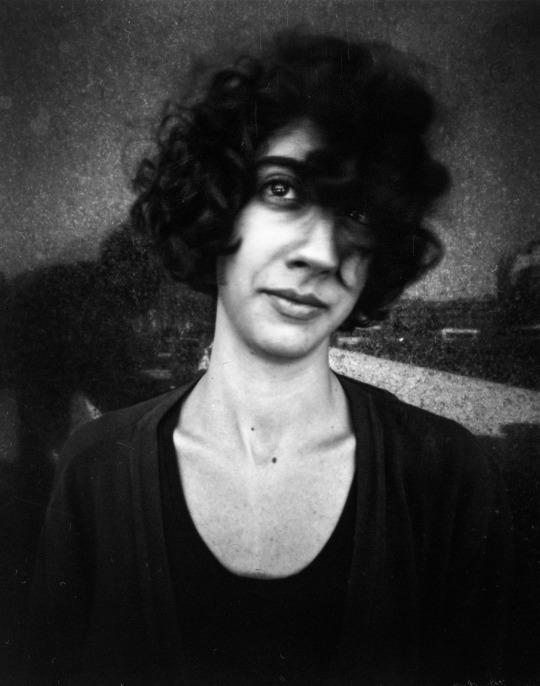A conversation between Buenos Aires and Ann Arbor, with Marcelo Cugliari and Will Callan.
Don't wanna be here? Send us removal request.
Photo

Given the nature of my work, I had to judge Clancy, an occasional colleague (no real names), based on his online behavior. There would be moments when I thought, something must be wrong with this man. When feeling more charitable, I would say, he’s moved by different music.
The one time I encountered Clancy out in the world it was a typically mild night in the city, on the corner of MLK and Locust. I passed the McDonald’s (the one that used to be there) and saw him through the window, alone at a table. A few weeks prior, news had come that the restaurant would be razed and replaced with a center offering social and medical services to homeless youth. Most people applauded, but Clancy lamented. “I’m gonna miss that place,” he wrote. I just so happened to be scanning the thread, and though his message was quickly buried in the feed, its ghost stood apart from the screen. It perplexed me, so I made a snap judgment: The line was an act of pure showmanship. It asserted that Clancy, out of charity and curiosity, mixed with the regulars at that McDonald’s; he went there to collect the noble attributes he claimed to observe in those people — hungry, deranged, and often belligerent, or simply looking for somewhere to sit — and incorporate them into his online persona. Despite its parking lot having been stage to the only murders I’d heard about it in some time, the McDonald’s was, for some, a haven, and here was Clancy, claiming status as one of its habitual pilgrims.
I satisfied myself with this conclusion for a few minutes. I read some dozens more comments, surrendered to YouTube; felt disgusted, washed my hands; and walked out of the apartment. Half a mile along the edge of the park, and Clancy was gone from my mind.

A few weeks later I was looking for a place to eat, and, deciding to play it safe, entered a taqueria. For $8 they were serving a chile relleno plate: two chile rellenos, rice, a light side salad, and a small bowl of black beans. The cashier wore a mechanic’s uniform, her name, Jeanine, sewn in blue script on a patch. She had gapped teeth and one of her eyes drifted out, such that I couldn’t be confident that she really, truly saw me as I ordered, not that it mattered to me, not really. I filled two or three plastic containers with hot sauce from the salsa bar and sat in the center. I sampled the rice and the beans. They were well-seasoned, -heated, and -textured. The rice was delicate and differentiated, the beans taut, but giving. With fork and knife I removed the tip of one of the rellenos. The filling steamed and the steam pillar split, revealing more clearly the layered cross section of white quesillo, dark green poblano, pale egg-batter, and golden brown shell. The layers felt as they looked, and tasted as they felt. Though it badly burned my mouth I dispatched those loaded peppers in just a few bites, and wiped up the mess with the rice and beans. I washed my palate with the humble salad. I quietly belched. Just as I finished, I heard shouting.
There was some disagreement between one of the cooks and a man who’d come in off the street. The man, short and muscular, threw his hands up and said, “I’m already late,” then stormed out. I made brief eye contact with the cook, who looked away sharply, stung. I cleaned up my table and left before the awkwardness could infect my mood.
I admit, I felt queasy, but luckily it did not mount and I kept my satisfaction with the meal as I wandered back home. Though decreasingly in the last ten years, the street still featured the sort of retail outfit that these days seems destined to fail, cavernous old thrift stores full of service industry uniforms, mannequins with missing limbs, and a few more sardonic employees than the payroll can support. In some of their upstairs apartments you can see a physician who will prescribe you almost anything. Despite being closed this time of night, all the shops illuminated their display windows. (Excessively, I thought, but that was OK.) And so, with that greasy, starchy mash seeping through me, I strolled the gum-spotted sidewalk and considered with a mixture of boredom and wonder the items spotlighted behind the glass: a dusty fedora, a wedding gown, a wicker basket; a backgammon set in a case of bone-colored leather, a book called Trees of Peru; a shoebox full of feminist comics from the 70s; a plant with broad green leaves.

I moved through the impromptu tour somewhat spellbound, such that when I reached the corner of Locust and MLK, the McDonald’s appeared by surprise. The front doors were accessible by a brief staircase or a ramp that ran along the side and below the broad windows, which held the patrons in a yellow light. A modest line had formed behind the counter. Some patrons, in groups of two or more, stood between the counter and the tables, there for no reason other than to socialize or plot. Only a few of the tables sat people. As I scanned their faces, someone approached me. “Come on, help me out. You wanna help me out?” He had a big brown nose, big blue eyes, a hairless face, and tapped his foot as he waited for my answer. It was the man who’d been kicked out of the taqueria. I pulled out my wallet and gave him a five. “More?” he asked. “That’s all I got,” I lied. He growled tenderly and flew up the steps.
He sat across from a large man wearing what was clearly a wig. It was shiny and long. He also wore a baseball cap, glasses, a scarf, and a brown overcoat. The man from the street spoke incessantly. The man in the wig clasped his hands and listened, nodding, cringing, widening his eyes, loosening his scarf when the tale raised its stakes. The first man slammed his fist on the table and pointed at the window, almost directly at me, and the man in the scarf turned to look. I recognized then it was Clancy. Could he have seen me? He jerked his chin up, such that his round glasses glinted, then broke his gaze. The man stopped talking, took a deep breath, and seemed to say thank you. Then he left. Clancy observed the other patrons for a while. He looked up at them, as if to invite them to join him. The crowd had grown so thick that when he left a few minutes later, he had to squeeze between their bodies, a task a man his size could not complete inconspicuously. But Clancy managed. Gracefully he wove through the chattering clusters of patrons. Many seemed to recognize him, and when he met resistance in the crowd, someone would push him, warmly, deftly, and send him spinning on his way. Clancy stiff-armed the swinging back doors. He must have marched across the parking lot with great speed, because when I rounded the corner and stood behind the waist-high chainlink, watching for him, I got nothing. Nor did I see his spirited friend. All I caught was the lump of a discarded wig, gleaming in the lamplight.

The McDonald’s is gone now, demolished. Construction has started on the homeless youth center that will replace it, which is being paid for by a local billionaire. Yesterday I heard on the radio that it will open ahead of schedule, and that every youth who passes through its doors will be welcomed with a hooded sweatshirt printed with their benefactor’s name.
0 notes
Text
There are only two Lincoln Town Cars in this city, that I know of. They are nearly identical, blue and slightly rusted with a black-leather interior. Both are the ’93 model, which kept the square angles and the spacious, hearse-like cab. The first is always parked outside the blue Victorian on Fourth Street. It caught my attention on a snowy day in February. Somehow, as the snow fell, and the other objects blurred, the Lincoln's colors, shape, and textures became all the more obvious. Since then, I’ve returned to its place almost daily. Despite the rust splotches, it seems in good condition, and I consider it a shame that it never gets driven. I’ve never seen its owner, not even a blind drawn from one of the house’s twelve street-facing windows. I have imagined sitting behind the wheel, windows down, sweeping across the outskirts of the city. My dreams have been illuminated by the vehicle’s sudden ignition, its headlights cast like lanterns over the gravelly dirt of a parking lot. I can tolerate its idleness thanks only to the existence of the second Lincoln Town Car, which I have already mentioned.

In appearance, this city tends to alternate between the suburban and post-industrial, but hardly ever the hard urban, unless you count the one-and-a-half, two commercial zones we have downtown. So why, you ask, do I call it a city? There’s your argument about the residents, who don’t carry themselves like city-dwellers. They walk more slowly, and chase after their loose children calmly. I even agree with you that its official title as a city bears little on this conversation, seeing as many of the nearby agro-burgs share the designation, which has much more to do with taxes than spirit, though of course the two overlap. All of this I acknowledge. And yet, I maintain: there is something decidedly urban about this place. A walk through its streets is an endless and endlessly surprising transformation. So I call this place a city, and you — you live with it.
These walks, not merely rhetorical, begin in the alley behind my apartment building. I keep my car in a parking area at the top of a flight of concrete stairs. Across the alleyway are fences, behind them backyards. Animals infest the weedy margin along the fences: rabbits, squirrels, and chipmunks; cardinals and robins; stray cats: a North American collection. One animal, a pet — a cream-colored, tawny-flecked hunting dog — barks at me wildly, working its head between the bottom of the fence and the dirt into the most agonizing looking position. It barks until I’ve disappeared. I usually go to the alley intending to walk to its end, out to the street. There, if I’m lucky, I’ll witness some notable vehicular (or vehicle-adjacent) behavior. One humid spring morning I watched a shipping truck trundle up the hill: fairly typical. But as I moved forward, a curious smell perked my nostrils. Somehow the bolt had slipped the rings and the doors had flung open, trailing steaming milk behind the truck (the smell was of cacio e pepe). On another occasion, two student drivers collided (harmlessly). They left their cars, squared off in a nearby tulip garden, and tussled until the weaker opponent shouted mercy, all while the instructors shared a cigarette and watched. And of course there was the day I saw the second Lincoln Town Car.
It was evening, I was standing on the sidewalk. The sun perched on the abrupt crest of the hill. Looking there, I shielded my eyes. A light wind blew in my direction, carrying the tang of smoke and leather. Then came the sound of the engine. The nose of a vehicle cleared the horizon. Its hood ornament, a silver cross, flashed. Backlit by the sun the body rose from the crest like a whale, and soared, or so it seemed to me, landing as it gained my position. The car glided past; its window was open: the dark blue paint, the silver spokes, the rust—and the face that looked at me with ash-colored eyes, head-on, forming the words, You’ve found me. I ran after it. It lost me. I continued, I ran for my life. But, doubled over across from the three-story Victorian, not a leaf seemed out of place. I caught my breath and approached the Town Car, fanned my palm across grill: no heat. I snapped to the house, but all the twelve windows were shaded.

I haven’t seen the second Town Car since that breezy evening, but boy, have I heard it. I hear it every day. It’s as though the sound were a type impossible to register until its source has been identified and internalized. Though the car crests the hill with astonishing regularity — astonishing for many reasons, not least of which the law — it never fails to surprise me. Dazed from my allotted hours at the screen, I shuffle to the window to catch the evening light. The hickory branches wag and the beech leaves lift and flutter. A robin pivots mechanically in the grass. As I’m about to turn, I hear the heavy buck of old suspension, followed by its airborne silence. Then the crunching impact, and screech into the distance. It is not uncommon in the seconds that follow to hear loud complaints from the sidewalk. I understand these people's concern and frustration, I do. That may be why I keep my distance. Because if I saw their faces, or read their angry bodies, I might take up their cause. I would harden against the second Town Car, and gradually, without noticing, lose faith in its power to redeem this place.
0 notes
Photo

Yet another person has reminded me of the book Shoe Dog by Phil Knight, the co-founder of Nike. All I know about this book is that at one point Phil describes reaching a level of wealth at which he feels entitled to wear sunglasses indoors. Or he describes someone else that way. I don’t know, because I haven’t read it.
That morning, on the day I was reminded of this book, I woke from what I’m tempted to call an anxiety dream, though the milder sort. I didn’t see its connection to Shoe Dog till the afternoon, but it did remind me of something, quite powerfully. Many years ago I was invited to a party by a good friend. It was a semi-formal gathering, of more or less like-minded and -experienced people, and to it I would likely be wearing a loose-fitting and colorful collared shirt, a blazer, and no tie, a combination in which I always felt comfortable, and therefore confident. In fact, when my friend, a very dear one whom, sadly, I have remained in poor touch with, asked if I would be her date, a significant share of my pleasure in accepting came from imagining the clothes I’d be wearing as together we moved through the knots of civilly chatting and in some cases heavily drinking partygoers, toward whom, almost without exception, we held a sort of restrained contempt (our shared suspicion of our peers is one reason we got along).
It wasn’t until the day of the event, which was to start at 8pm (being midsummer, the sun would still be full in the sky), that I realized my outfit would include another item, and not an inconspicuous one. That day I had my once-every-three-years appointment at the optometrist's to have my prescription adjusted, so that, in compliance with some article buried in my insurance policy, I could get a new pair of glasses. As part of the standard routine, the optometrist, of whom I remember nothing—not gender, manner, face, or voice—dispensed in each eyeball the stinging yellow drops that would dilate my pupils and allow him/her to flash into their depths a medical-grade LED light. As most people know, it takes hours for the drug to wear off and the pupils to constrict, such that raw exposure to even mild light causes great pain and possibly permanent retinal damage. For this reason, after the procedure, it’s typical for the assistant to hand you a disposable pair of sunglasses. They are made of a rather stiff plasticky material that comes rolled up in the size of a film canister. You unroll it, place the edges at your temples, and with centripetal pressure the tinted plastic clings to your face, giving you the look of either the Terminator or a nursing home resident. Of course, as I left the office that day, I was offered the complimentary eye-protection, but I declined them. I donned my own sunglasses—tortoise-shell Ray Bans, prescription, with a green and sunscreen-caked connector in the back to keep the glasses on my body should they ever be knocked from my face—and thanked the assistant for her time.
A few hours later, my pupils still blown wide, I arrived at the semi-formal shindig in my blazer, shirt, and Ray Bans. We got our drinks and, as expected, milled about in quiet judgment of the others. Most of this being indoors, a few of the people we spoke with gave me questioning looks. Others went so far as to lightly suggest, through innuendo, that those who don’t show their faces indoors have a problem with people that ought to be fixed. My friend and I knew quite well what they were getting at, and later, after the sun had gone down and we sat on the grass, removed from the others, I felt happy and entirely forgetful of their comments. They hadn’t bothered me a bit.
So why, all these years later, do I find myself sluggish and achey in my bed, replaying the dream? I am entering a restaurant with only my prescription sunglasses on hand, and therefore the choice between two types of partial blindness: one darkened, one blurry; one judgment-raising, one simply frustrating. The restaurant is crowded and moderately lit. For some reason the glossy wood of our table and hanging lights reflected there make me expect to see fish tacos and asparagus salad on the menu. Though we are seated, I have yet to make my decision, glasses or no, and the other patrons, watching, seem to be aware of that. One thing is for sure: I can’t see clearly, least of all the faces of my friends, if that’s what they are. Whatever they are, they do not include my sarcastic friend from the semi-formal party. Maybe it’s fortunate that between the menu, my decision, and my swelling discomfort, I have scarcely a moment to think about who surrounds me, but if I did, I would be hopeful, though doubtful, that she might be among the hundreds, possibly thousands, eating lunch in this gigantic space.
0 notes
Photo

I’ve heard surprisingly few people describe the sound of a whistling train, but those I have heard gave me plenty to work with. One called it lonesome. The other, mournful.
The whistle reminds you of the extent of the landscape, the tracks you may have crossed or moved along, with their crickets, sticks, and dry, bent grass, and the people in the train cars, slouching, sleeping, with straight backs and hands on their knees, wide awake, all moving as one. Primarily a warning, the whistle also secures you in your place. But too close to the tracks, you’re in hell.
The family—two parents, one girl, a horse, and a cart—found the house in 1913 (or thereabouts). For a few weeks they camped at its edges. Each night they built a small fire whose heat mingled with the clean iron smell of the nearby slaughterhouse. They made tentative bonds with distant neighbors, gleaning information. Once confident the house had been abandoned, they infiltrated and settled. With money from construction work and sales of bracelets made from river stones, they built a concrete water tank. They planted herbs and small flowers in the strip of soil out front. A blue-eyed dog appeared by the fire one night, and stayed.

In the distance, the city was rising. One day it sent a representative, a bearded, well-dressed man. He arrived below their windows and set the dog barking. The next day more men came, with tools, and the family was made to consent.
For ten years the girl lived in that disintegrating house, until both her parents died. Later in life she would jolt awake in anticipation of the deep, endless rattle of the train.
The shape of the roof, aerially speaking, is one question. Another is the types of flowers the family grew (and now, those that curl around the bushy weeds). Marcelo, being crafty, dressed in black and not exactly smiling, may have planted clues in the portrait, whose Picasso’s-Gertrude-Stein eyes offer us a choice: to move towards or away from a sound that is comforting, lonesome, and mournful.
0 notes
Photo

I wanted to respond slantwise and high-mindedly to these photos, but realized a few problems with that approach, the biggest of which is that it distracts with false complexity.
What relieves me about photography as a medium is that it takes, from my non-photographer perspective, enormous effort to make the work product obscure. The camera captures what’s there.
If you snap a shot of some sheet metal supported precariously by lumber on a cloudy day, and you want to strongly suggest, I don’t know, that it represents—or is—a shard of God’s powder-room mirror, warped and dirtied in its fall, you’re going to have to hire some loiterers to “pray” in front of it and maybe a team of celestial archeologists to “upset” the devotees with their methodical destruction, all to contrive a little drama for your camera eye, which eye, in such a case, could no longer call itself a chance observer.
If, some cloudy evening, you want to give a subject with lovely thick hair qualities of both paint and flesh (and sand, and space, and smoke!), you don’t bury them in makeup and ask them to breathe on the lens (though it should be acknowledged this photo was shot through a pinhole).
No. The real work happens in the transfer of the image between eyes: the photographer’s, the camera’s, and yours (and whichever eyes come before the photographer’s).

This blog is meant to be a conversation between Marcelo, a photographer from Buenos Aires, and me, a writer about to be living in Ann Arbor, Michigan. Last June Marcelo showed me around a Facundo de Zuviría exhibit at the CCK in Buenos Aires. He had a black eye (longboarding accident). Now he sends me photos.
In the case of these photos, if what I said above is true, they already contain all you need to know.
I might just add that in the portrait, we have a subject whose hair, eyes, and constellated moles are all the same lustrous almost-black. Her smile is vague and the lines of her clavicle are hard and clear. She sees something we think we see but don’t, and never will, because look, her face is twisting, she’s about to get sucked from this place to the next.
As for the possible powder-room mirror, that was a joke I regret. I would just recommend you pay attention to the tidy pile of luminous white gravel at the base of the very earthly sheet metal. The toxic mud it rests on may not be so toxic after all. If people have passed it, they’ve taken care to preserve it. The clouds hover at a distance like a longhaired, intelligent cat, sensing before we do the hidden something that will soon be obvious.
0 notes